Rodents of unusual size, or ROUS, are bloodthirsty creatures in The Princess Bride, but their closest counterparts in the real world are capybaras or the massive Bosavi woolly rats of South America.
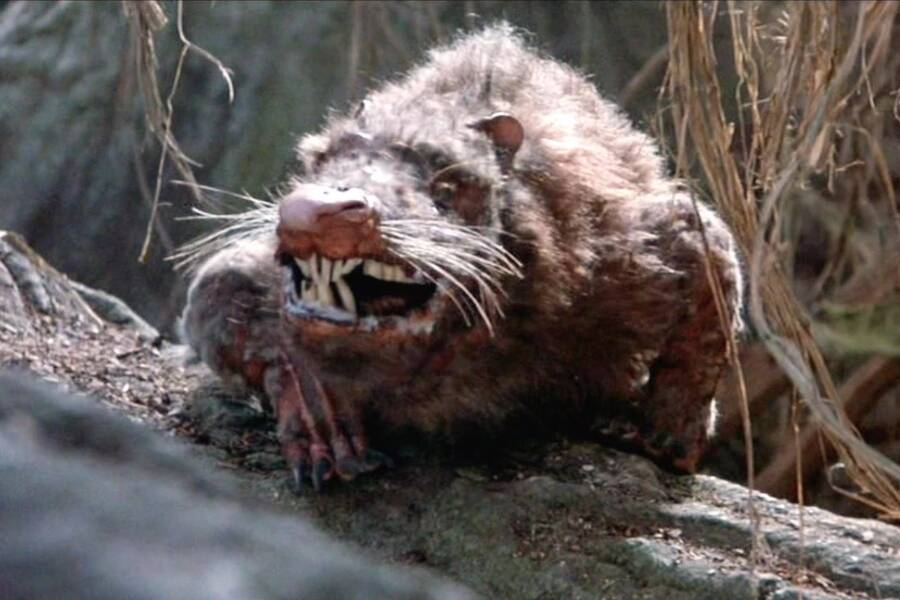
20th Century Studios/MGMA “rodent of unusual size,” or ROUS, from The Princess Bride.
In the 1973 novel The Princess Bride, Buttercup and Westley are taken by surprise when they are suddenly attacked by “rodents of unusual size,” or ROUS. The book describes the beasts as a “pure rat strain” that lives in the Fire Swamp. The animals weigh as much as a large dog, eat a carnivorous diet, run as fast as a wolfhound, and attack if they smell blood.
The creatures also appear in the 1987 film adaptation of the book. The onscreen rodents of unusual size are nearly as big as humans, but viewers can take some solace in knowing that these creatures are just the result of movie magic. Or are they?
It isn’t actually that simple. While we may be accustomed today to smaller creatures like mice, rats, hamsters, and squirrels, massive rodents once roamed the Earth. They weren’t all that different from today’s rodents — they were just much, much larger.
Of course, it’s not entirely accurate to say real-life rodents of unusual size were only a thing of the past. There are certainly a few modern creatures that could hold that title, though most of them aren’t quite as terrifying as the ROUS from the Fire Swamp.
‘Josephoartigasia Monesi’: The Largest ROUS To Ever Roam The Earth
In prehistory, land-dwelling animals were often much larger than their modern counterparts. Australia, for example, had many species of megafauna during the Pleistocene Epoch. They outlasted their cousins on other continents, too. Then, roughly 70,000 years ago, the first Aboriginal Australians arrived and hunted many of them to extinction (or otherwise caused environmental changes that led to their demise).
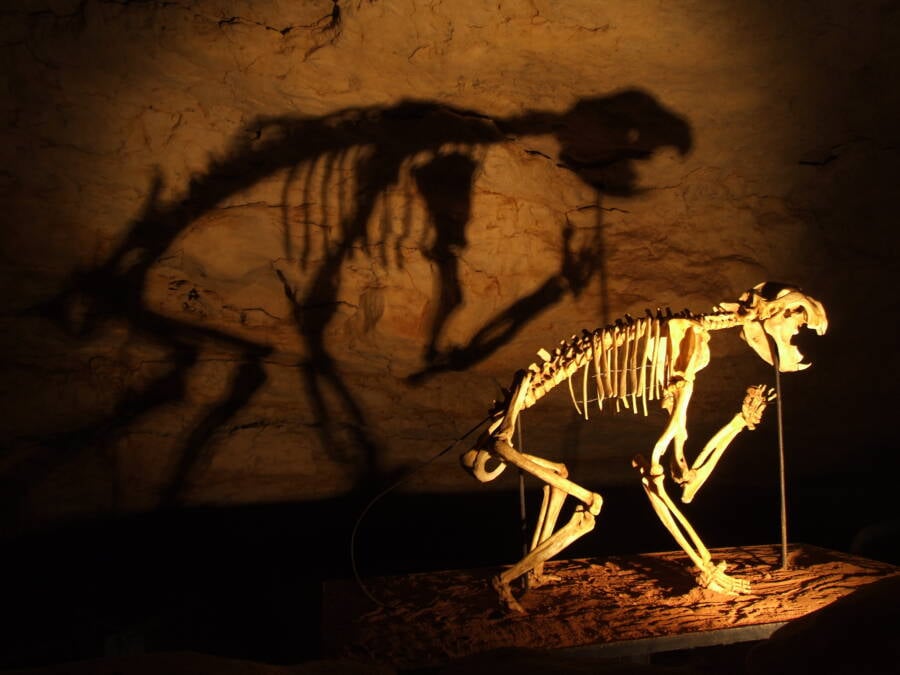
Public DomainThe skeleton of a marsupial lion that once roamed the Australian continent.
While Australia still has some fascinating, unique animals that are rarely seen elsewhere, it was hardly the only place on Earth to host prehistoric megafauna. In fact, some of the largest rodents ever found were discovered in unexpected places.
In January 2008, for example, The Guardian reported that fossil hunters in Uruguay unearthed a four-million-year-old skull from a prehistoric rat that’s believed to be the largest rodent to ever walk the Earth. The skull itself measured about 18 inches in length, and researchers estimated the creature would have been nearly 10 feet long and five feet tall.
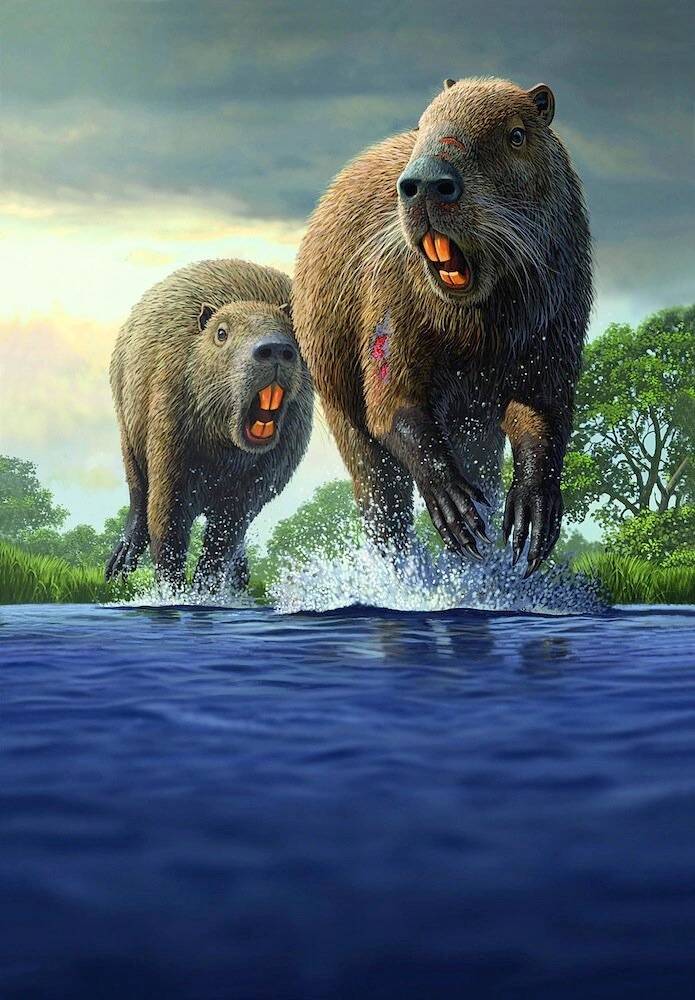
The Animal DatabaseAn artist’s interpretation of Josephoartigasia monesi, the largest rodent to ever live.
This giant rodent was given the name Josephoartigasia monesi, and artistic interpretations are terrifyingly similar to the rodents of unusual size from The Princess Bride.
Despite its size, J. monesi likely wasn’t a carnivore, given its small teeth and weak jaw muscles. J. monesi does have a modern-day relative, the pacarana, though it is naturally much smaller. Still, pacaranas typically weigh around 30 pounds, which is quite large for a rodent.
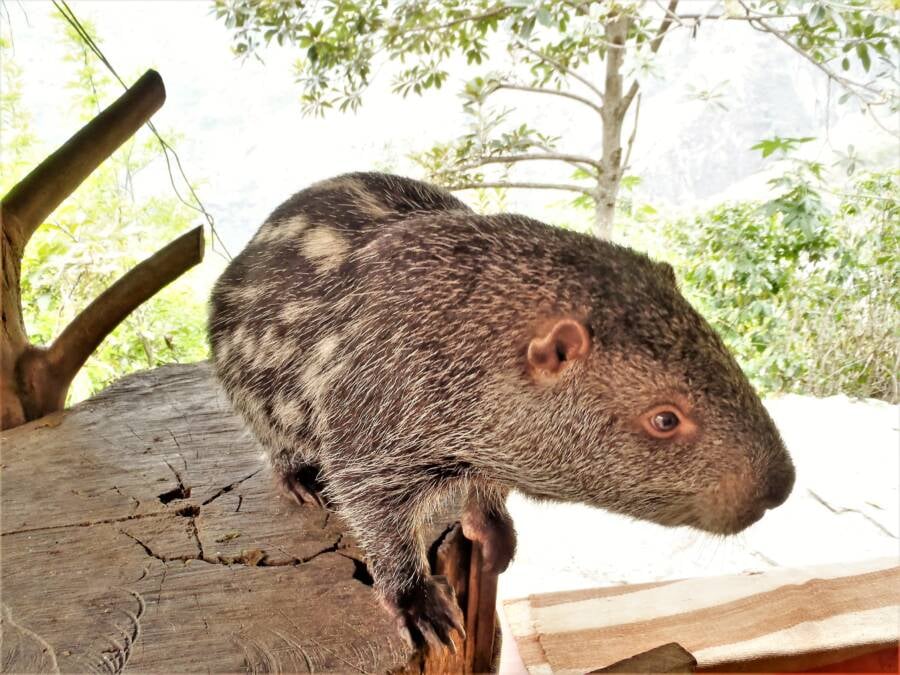
Benjamin Frable/Wikimedia CommonsThe pacarana, the closest living relative of J. monesi.
J. monesi was a unique rodent, though. The ROUS seen in The Princess Bride are clearly meant to resemble rats. So, are there any real-life examples of giant rats that could compare?
As it turns out, the answer is yes.
Rodents Of Unusual Size Found In Papua New Guinea
In 2009, a team of scientists from the Smithsonian Institute discovered a giant rat in the crater of an extinct volcano in Papua New Guinea. It was most certainly an unusual size, as it measured 32 inches from nose to tail and weighed three-and-a-half pounds.
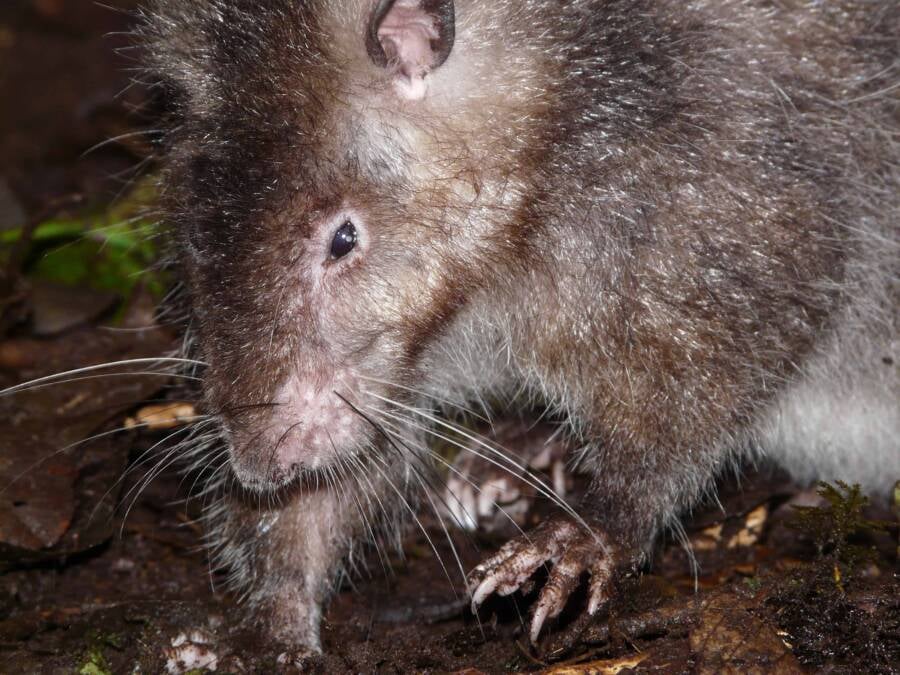
Kristofer Helgen/Smithsonian InstituteThe Bosavi woolly rat, the rodent of unusual size discovered in a volcano crater.
Granted, this rat was still a good deal smaller than the ROUS in The Princess Bride. However, compared even to the rats often found on the streets of New York, which don’t typically grow past two pounds, it was gargantuan. The team that spotted the rat included the curator of mammals at Smithsonian’s National Museum of Natural History in Washington, D.C., Kristofer Helgen, who said of the discovery, “Our hearts were in our throats. It was an unbelievably exciting moment. It was all the more incredible that the BBC was there to film it.”
Curiously, the research team said the rat was completely docile when they found it, suggesting that it, much like the adorably cheerful quokka, was not familiar with humans. They named the creature the Bosavi woolly rat due to its thick, silvery fur.
“It is a true rat,” Helgen said, “closely related to the rats and mice most of us are familiar with, but so much bigger.”
The Bosavi woolly rat was certainly a shocking new discovery more than a decade ago, and it could technically be classified as a rodent of unusual size. However, there is still one other contender that may be more deserving of the crown: the capybara.
Capybaras, The Largest ROUS Alive Today
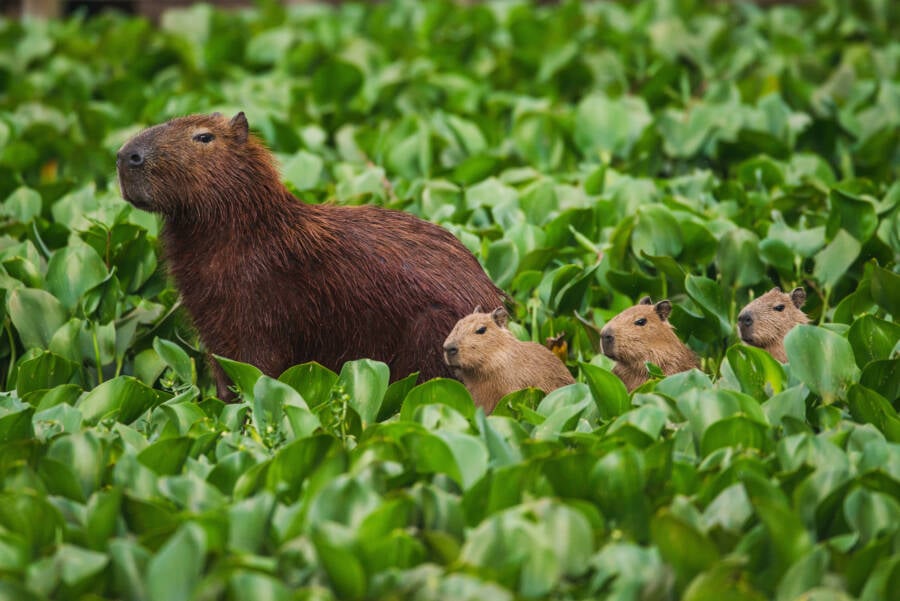
Clodomiro Esteves Junior/Wikimedia CommonsA mother capybara with her pups.
Capybaras aren’t quite as rare as the Bosavi woolly rat, given that they are considered a species of “Least Concern” by the International Union for Conservation of Nature. For a long time, though, they were rarely seen outside of their natural habitats in South America. Today, capybaras can be found in many zoos across the world, and people from every continent can see these magnificent creatures. Large capybaras are around four feet long, two feet tall, and weigh more than 150 pounds, making them the biggest rodents in the world.
These real-life ROUS are semiaquatic mammals and live in a range of environments across South America, including savannas, dense forests, and wetlands. They are particularly abundant in countries like Brazil, Venezuela, Colombia, and Argentina, and they prefer to live in areas near bodies of water such as rivers, lakes, and marshes due to their adept swimming abilities and reliance on aquatic vegetation for food. In fact, their name derives from the Tupi language, meaning “master of grasses.”
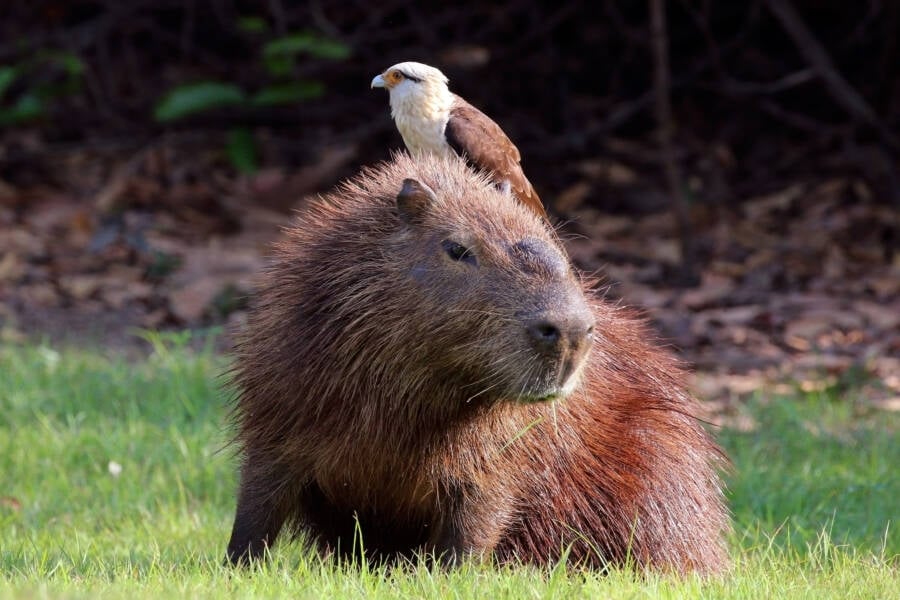
Charles J. Sharp/Wikimedia CommonsA caracara resting on top of a capybara’s head.
Like other rodents, capybaras are herbivores that primarily feed on grasses, aquatic plants, fruits, and tree bark. They have a unique digestive process that includes coprophagy — the consumption of their own feces — to maximize nutrient absorption from their fibrous diet, essentially allowing them to extract essential nutrients that weren’t absorbed during the first digestion cycle. Their teeth also grow continuously, making them well-suited for grinding down tough plant materials to ensure the animals can efficiently process their food.
Capybaras are highly social animals. They live in groups of 10 to 20 individuals, but during dry seasons, these groups sometimes collect around whatever water they can find to form aggregations of up to 100 creatures. They also have a fairly complex form of communication that involves a variety of vocalizations, such as purrs, barks, whistles, and clicks.
Though fairly far removed from the rodents of unusual size in The Princess Bride, the capybara is by far the closest modern animal comparatively. Thankfully, capybaras are also significantly less hostile toward people — something we should all be happy about.
After learning all about rodents of unusual size, read about rat kings, the super-rodents made out of tangled tails. Then, learn about the pitcher plant, the two-foot-tall carnivorous plant that gobbles up rodents.





